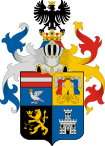Tokaj
Tokaj | |
|---|---|
 | |
| Coordinates: 48°07′17″N 21°24′45″E / 48.121443°N 21.412468°E | |
| Country | |
| County | Borsod-Abaúj-Zemplén |
| District | Tokaj |
| Area | |
• Total | 28.2 km2 (10.9 sq mi) |
| Population (2017) | |
• Total | 4,155[1] |
| Demonym | tokaji |
| Population by ethnicity | |
| • Hungarians | 85.3% |
| • Romani | 1.3% |
| • Germans | 0.6% |
| • Slovaks | 0.2% |
| • Ruthenians | 0.1% |
| • Ukrainians | 0.1% |
| • Others | 0.8% |
| Population by religion | |
| • Roman Catholic | 29.0% |
| • Greek Catholic | 10.1% |
| • Calvinists | 20.0% |
| • Lutherans | 0.6% |
| • Other | 0.7% |
| • Non-religious | 8.6% |
| • Unknown | 31.0% |
| Time zone | UTC+1 (CET) |
| • Summer (DST) | UTC+2 (CEST) |
| Postal code | 3910 |
| Area code | (+36) 47 |
| Website | www |
Tokaj (Hungarian pronunciation: [ˈtokɒj] ⓘ) is a historical town in Borsod-Abaúj-Zemplén county, Northern Hungary, 54 kilometers from county capital Miskolc. It is the centre of the Tokaj-Hegyalja wine district where Tokaji wine is produced.
History
[edit]
The wine-growing area was first mentioned by the name Tokaj in 1067. The town itself was first mentioned in documents in 1353. Its first castle was a motte, which was destroyed during the Mongol invasion of Hungary. By the 14th century, the town already had a stone castle, belonging to the Diósgyőr estate.[4]
After 1450, Tokaj was the property of the Hunyadi family, so after Matthias Hunyadi became king, the town became a royal estate. In 1526, after the Ottomans captured Petervarad (modern day Petrovaradin, Serbia), Cistercians from Petervarad and its surroundings relocated to Tokaj and greatly improved wine making in the area. In 1705, Francis II Rákóczi ordered the castle to be destroyed.
After the Austro-Hungarian Compromise of 1867, the town prospered, but when the World Wars came, it suffered greatly, losing its importance and town status. Even its role in wine trade was taken over by Sátoraljaújhely.
Tokaj was granted town status again in 1986 and it again started to prosper. Now, the town is a popular tourist attraction.
Tokaj wine region
[edit]
Tokaj wine region is a historical wine region located in northeastern Hungary and southeastern Slovakia. It is one of the seven larger wine regions of Hungary (Hungarian: Tokaji borrégió). Hegyalja means "foothills" in Hungarian, and this was the original name of the region.
The region consists of 28 named villages and 11,149 hectares of classified vineyards, of which an estimated 5,500 are currently planted. Tokaj has been declared a World Heritage Site in 2002 under the name Tokaj Wine Region Historic Cultural Landscape. However, its fame long predated this distinction because it is the origin of Tokaji aszú wine, the world's oldest botrytized wine.
Twin towns – sister cities
[edit] Binyamina-Giv'at Ada, Israel
Binyamina-Giv'at Ada, Israel Cormons, Italy
Cormons, Italy Dej, Romania
Dej, Romania Iwonicz-Zdrój, Poland
Iwonicz-Zdrój, Poland Oestrich-Winkel, Germany
Oestrich-Winkel, Germany Rust, Austria
Rust, Austria Sonoma, United States
Sonoma, United States Supetar, Croatia
Supetar, Croatia
Main sights
[edit]- Main square with City hall; the Bacchus fountain; the Catholic Church; and other monuments
- Roman Catholic Church
- Tokaj Gallery (former Orthodox church—government has announced intentions to restore[6])
- Tokaj Museum (Karácsony house)
- Wine cellars
- Rákóczi-Dessewffy castle
- Tisza bridge
- Synagogue
- Tokaj open stage (″Fesztivalkatlan″)
-
City center
-
Bacchus fountain
-
Interior of Roman Catholic Church
-
Jewish cemetery
-
River Tisza in winter with Tokaj bridge
External links
[edit]![]() Tokaj travel guide from Wikivoyage
Tokaj travel guide from Wikivoyage
References
[edit]- ^ Tokaj, KSH
- ^ KSH - Tokaj, 2011
- ^ KSH - Tokaj, 2011
- ^ A tokaji vár története
- ^ "Rendeletek 14/2019.(XI. 29.): A Képviselő-testület Szervezeti és Működési Szabályzatáról". tokaj.hu (in Hungarian). Tokaj. 2019-11-29. p. 15. Retrieved 2021-01-11.
- ^ "Hungary Allocates $8 Million to Restore Orthodox Churches". 8 February 2017.











